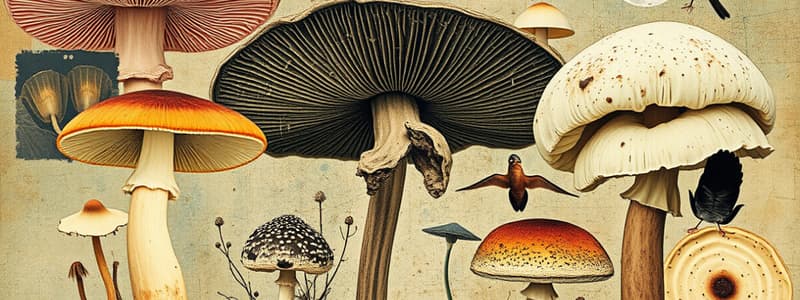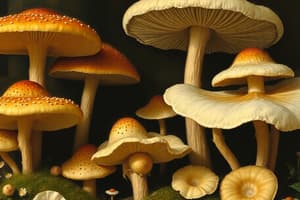Podcast
Questions and Answers
What classification best describes fungi in relation to nutrition?
What classification best describes fungi in relation to nutrition?
- Producers that rely solely on sunlight
- Photosynthetic organisms like plants
- Autotrophs that produce their own food
- Heterotrophs that absorb nutrients from external sources (correct)
How do fungi contribute to the ecosystem?
How do fungi contribute to the ecosystem?
- By decomposing dead organic matter (correct)
- By competing with plants for sunlight
- By serving as primary producers in food chains
- By producing oxygen through photosynthesis
What is a key characteristic that differentiates fungi from plants?
What is a key characteristic that differentiates fungi from plants?
- Fungi are not part of any biological kingdom
- Fungi are autotrophic like plants
- Fungi have more in common with animals in cell structure (correct)
- Fungi can perform photosynthesis
What relationship do some fungi maintain with trees?
What relationship do some fungi maintain with trees?
Why might fungi be considered vital in addressing environmental issues?
Why might fungi be considered vital in addressing environmental issues?
What significant contribution to human health did fungi make in 1928?
What significant contribution to human health did fungi make in 1928?
Which of the following is a harmful effect of fungi mentioned in the content?
Which of the following is a harmful effect of fungi mentioned in the content?
How do fungi assist in the survival of trees in forests?
How do fungi assist in the survival of trees in forests?
What was one consequence of the potato blight caused by fungi?
What was one consequence of the potato blight caused by fungi?
What is a characteristic of fungi that makes them both beneficial and harmful?
What is a characteristic of fungi that makes them both beneficial and harmful?
Flashcards are hidden until you start studying
Study Notes
Classification of Fungi
- Fungi include mushrooms, yeasts, and moulds, with around 144,000 identified species and an estimated 3.8 million total species.
- Fungi were formerly classified with plants but share more cellular characteristics with animals, leading to their recognition as a separate kingdom.
Ecological Roles
- Fungi are heterotrophs and cannot produce their own food; instead, they absorb nutrients from external sources.
- They play a crucial role as decomposers, breaking down dead organic matter and recycling nutrients in ecosystems.
- Certain fungi are capable of degrading plastic, presenting a potential solution to environmental plastic pollution.
- Fungi establish symbiotic relationships, such as mycorrhizal associations with trees, where they exchange nutrients for sugars.
Contributions to Humanity
- Essential in food production, fungi are used in the fermentation processes of bread, wine, and beer.
- Penicillin, the antibiotic discovered by Alexander Fleming in 1928, originated from the mould Penicillium and has saved an estimated 200 million lives.
Dangers and Diseases
- Some fungi can be harmful or lethal to humans, animals, and plants.
- Historical impact includes potato blight, which caused famine in 19th-century Ireland, and Dutch elm disease, which has devastated millions of elm trees in the UK.
Overall Significance of Fungi
- Fungi significantly influence ecosystems and human culture, underscoring the need for increased awareness and understanding of their diverse roles.
Studying That Suits You
Use AI to generate personalized quizzes and flashcards to suit your learning preferences.




